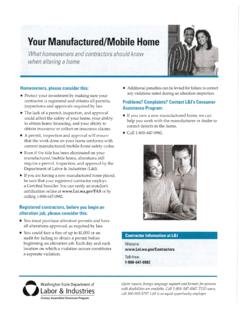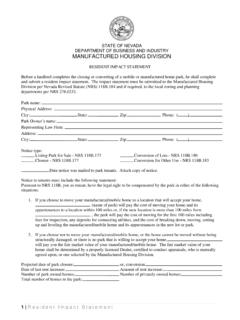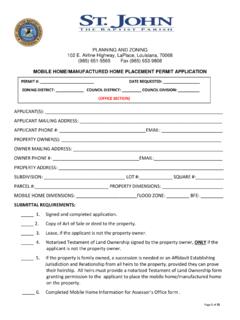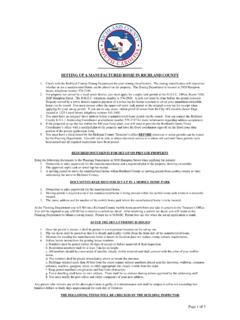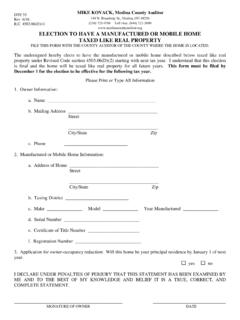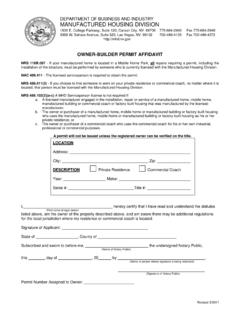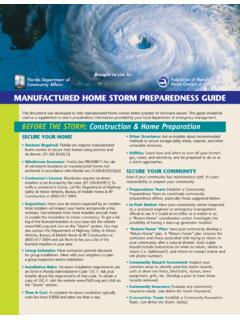Transcription of Do-it-Yourself Mobile Home - cvoeo.org
1 Do-it-YourselfMobileHomeEnergy EfficiencyWritten and Produced by:The Mobile home Project (MHP) of the Coordinated Statewide Housing Servicesdivision of the Champlain Valley Office of Economic Opportunity (CVOEO)Design: Futura DesignCopyright Edition, October 2009 Simple tips to help Vermont s Mobile homeresidents save money, save energy,and live more Energy Efficiency Initiative of the Mobile home Project wasfunded by the American Recovery and Reinvestment Act (ARRA)CSBG funds. This guide draws extensively from the concepts con-tained in the Department of Housing and Urban Development(HUD) publication: Manufactured Homes: Saving Money by SavingEnergy, 2005 and the Vermont Department of Public Service publi-cation: The Vermont Mobile home Energy Book.
2 Special thanks tothe CVOEO Weatherization Service in Hinesburg for their expertadvice and input. NoticeFollow all safety instructions from both this guide and the manu-facturer. Before you attempt any improvement on your heatingsystem, hot water system, under or around your home , make surethe area is safe. If you suspect that there may be a problem, contacta professional immediately. Do-it-Yourself Mobile home Energy Efficiency is produced by theMobile home Project (MHP) of the Champlain Valley Office ofEconomic Opportunity (CVOEO) and written by Logan Zingus,Energy Efficiency Coordinator for the MHP. The MHP is a programof the Coordinated Statewide Housing Services division of MHP provides advocacy, education and housing assistance formobile home park residentsTo contact the MHPMail or in person to:294 North Winooski Ave.
3 , Burlington, VT 05401 Phone:802-660-3455 Fax:802-651-4179 of Contents1. Introduction.. 22. Heating systems .. 33. Air sealing .. 44. Windows and doors .. 65. Lighting and appliances .. 86. Hot water .. 97. Insulation .. 118. Moisture control, ventilation and air quality .. 129. Safety .. 1310. Resources .. 14Do-it-YourselfMobileHomeEnergy EfficiencyTop Priorities GuideProfessional furnace maintenence .. 3 Clean or replace furnace filter .. 3 Seal leaky ducts .. 4 Install interior storm windows.. 6 Install CFL bulbs .. 8 Insulate hot water tank and pipes .. 9 Insulate underbelly .. 1121. IntroductionAll homes are subject to wear and tear. Vermont s dramaticseasonal temperature changes, combined with wind, snowand sunlight, can open leaks in your home s shell, ductwork,windows and doors.
4 Leaks allow warm air to escape, whilecold air is drawn in. Heating and cooling systems also loseefficiency after years of use, and must be cleaned and main-tained properly. Although your home was built to the energystandards of the time, tremendous improvements have beenmade in housing technologies and our understanding of homeenergy use. Mobile homes require special weatherization solu-tions because they are exposed on all sides, including theunderbelly, and are often made of lighter, less durable materi-als. As energy prices continue to rise, it is especially importantto consider the efficiency of your reading this manual, you are taking the first step to makingyour Mobile home more energy efficient. The following tips andtechniques are compiled from multiple sources and first handexperience to present the easiest and most cost-effective waysto save energy.
5 It should serve as a guide to be read throughonce a year, and to be consulted as specific problems arise. Ingeneral, the first measures are the most important. The mostcost-effective measures are indicated by asterisks.*BE SURE TO FOLLOW ALL SAFETY INSTRUCTIONS32. Heating SystemsProfessional furnace maintenance*Have a heating professional service your furnace once a year soit can run at maximum efficiency. Beware of contractors whotake short cuts. Try to use an independent heating contractor. Clean or replace furnace filter*The furnace filter can be foundclipped to the interior of thefurnace door and can be easilyremoved and either vacuumed,washed or shaken out. Keep anextra filter on hand they arereusable, but they don t last a programmable thermo-stat, keep it set appropriatelyand cleanA programmable thermostat will help you auto-matically adjust the temperature in your home accord-ing to time of day, although it s not a necessity.
6 Lower thetemperature before going to bed and during the day if no oneis home . A 5 reduction in temperature for 8 hours every dayresults in a 5% saving of the annual heating furnace registers, ensure they are free ofblockagesYou should also leave all registers open to allow enough air toreturn back to the furnace. It may seem like a waste to have openregisters in unused rooms, but closing registers can starve thefurnace of air and cause it to short cycle, which could damagethe heat exchanger and destroy the furnace. Furnace filter14 Keep bedroom doors slightly ajarYour furnace is built to a specific size to heat your entire recir culates the warm air to run efficiently. By sealing offrooms, the furnace can t get enough return air to circulate, so ithas to work harder to heat the home .
7 Unless there is at least aone inch gap between the floor and door, try to keep the bedroomdoors ajar to allow enough air to sunlight to come through windows on cold days,close the blinds at night3. Air SealingSeal leaky ducts*Sealing leaky ductsproduces some of thehighest energy savingsrelative to cost of anytechnique. The first places toseal are the seams around supply boots (connecting piecebetween the main duct and each floor vent). Remove the floorvent top plate (register) and look at the connection. If there isno sealant around the joint, use acrylic mastic (available atmost hardware stores) to cover the seams of the every register. The next best places to seal are the ductends (termination caps), which you will find near the lastregisters at the far ends of the home .
8 You may need to use amirror and flashlight to see the duct ends. Common duct leak locations25 Air conditionersRemove window air condi-tioners in the winter, as airleakage will occur throughthe unit and around itsperimeter. If you are unableto remove it, cover both theinterior and exterior of theunit with specially designedcovers, which can be foundat most hardware stores. Youcan also use heavy duty garbage bags. VentilationCheck the vents of your bathroom fan, range hood and should all lead to the outside of your home with a sealedpipe. They should not exhaust into the crawlspace or attic. Thevent damper should seal well to the vent, and be able to openwhen the fan is in use. If the vent is cracked or not functioningproperly, you can easily install a new vent.
9 Simply unscrew theold vent on the exterior of you home and screw in the new a metal vent with a screen for animals for the bathroomand range hood vents. A dryer vent should not have an animalscreen because it can trap leaksOften times you can feel colddrafts entering the home . Seekout the leaks you can use alit cigarette or incense on awindy day to pinpoint thesource of a draft. The bestplaces to check are: plumbingareas (under sinks and bath-tubs), gaps around light fix-Air conditioner coverSmall leak in cabinet sealed with foam6tures, joints around the main structure and add-ons, electricallines and service panel boxes, and where the furnace ventmeets the ceiling (use high-temp caulk). Leaks that are smallerthan a quarter inch can be filled with latex caulk rope caulkworks well for sealing windows, doors and other long leaks may need expanding foam.
10 Only use expandingfoam on covered areas (such as underneath sinks) and makesure it s fire retardant (many are not). Very large gaps mayrequire a piece of material similar to the material of the surfacebeing patched. Adhesive should be applied to the patch andremaining gaps should be sealed with caulk. Always ventilatethe area when using expanding foam as it is toxic. If you planon painting over caulk, make sure it s paintable. Air sealing is not permanent The large differences in temperature in Vermont cause materialsto expand, contract, and shift, which means seals can your home for leaks every year. 4. Windows and doorsPlastic wrap windows or install interior storm windows*Many people look to replacing their windows to increase theirhome efficiency and stop drafts, however it s usually more costeffective to air seal existing windows by using an 8 mil thickplastic wrap.

